|
4/21/2014 Pelvic FloorThe pelvic floor is an important and often overlooked part of the body that holds the abdominal organs in place. Often times the pelvic floor can be chronically tight and when a teacher asks you to engage Mula Bandha, you may wonder what in the world that is, firs off. Secondly it is difficult to engage a set of muscles that are already chronically tight. As we age, these muscles may loose their elasticity (especially if they are held in chronic contraction for many years on end) and a host of pelvic issues may result, including incontinence. This week we will learn to access the pelvic floor from the lower belly and begin to feel how the movement of the pelvic floor mirrors another muscular wall in the body, the diaphragm.  Chant UUU Sit comfortably with the legs crossed. Begin to breathe into the lowest belly, way down to the area behind the pubic bone. As you exhale chant UUU in a low pitch to activate the pelvic floor, repeat for 1 minute. Elevator Breath Begin watching the breath and imagining that the breath is like an elevator car. Where it comes into the nose is the penthouse and the pelvic floor is the basement of our imaginary building. As you inhale feel the breath move down the elevator shaft in the center of the body from the penthouse (nose) to the basement (pelvic floor). As you exhale feel the breath move up the elevator shaft from the pelvic floor back up and out through the nose. Repeat this for a few rounds until it becomes comfortably. Then begin to add a slight lower abdominal contraction on the exhale only and notice if there is a corresponding lift to the pelvic floor. When you inhale, make sure to completely relax the belly. The pelvic floor should mirror the movement of the diaphragm, when you inhale they both dome downward, and when you exhale they both gently lift toward the crown of the head. Reclining Vinyasa I Begin lying on the back with the legs straight and arms extended over the head, take an inhale to prepare. Exhale and draw the right knee into the chest, holding it with the right hand. Inhale draw the right knee out to the right side with the right hand, left hand in cactus on the floor. Exhale and cross the right knee over to the left side of the body with the left hand, right hand in cactus on the floor. Inhale back to the center and extend the right leg up toward the ceiling, holding behind thigh with the clasped hands. Exhale draw the right knee to the chest. Inhale extend the leg to the floor and the arms overhead. Exhale and repeat the entire sequence with left leg. Spider Walk Lie on the back with a folded blanket under the sacrum. Draw the wide knees into the chest and hold behind the knees, keeping the ankles flexed. Inhale and straighten one leg out to the side, exhale and bend that leg. Repeat alternating sides for about a minute. 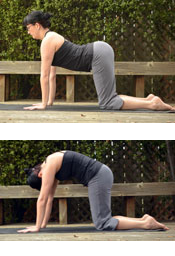 Cat/Cow Tilts: Cow: Begin on the hands and knees, toes pointed. Inhale lift the sternum forward and drop the pubic bone back between the legs to arch the spine. Feel how the pelvic floor opens in this position. Cat: Exhale round the back and drop the head and tail bone towards the floor. Feel how the pelvic floor tightens in this position. Repeat with your breath 10 times.  Sphinx Lay on belly with legs together and toes pointed back. Bring forearms to floor with elbows aligned under shoulders and forearms parallel to each other, palms facing down. Lift sternum forward and up through crown of head. If lower back feels vulnerable, engage belly away from floor. Do not contract the pelvic floor and see if you can return to the sensation of the pelvic floor moving down in inhale and up on exhale. Hold 5-10 breaths and release chest to floor with hands under forehead.  Adho Mukha Svanasana (Downward Facing Dog) Begin on all fours with hands slightly forward of shoulders. Turn toes under and lift knees off the floor. Keep shoulders wide and palms flat, press thighs and sit bones back, scooping belly in. Feel how the four bones of the pelvic base, the two sit bones, the pubic bone and the tail bone all reach up toward the ceiling. Hold 1-3 minutes, release onto the hands and knees. 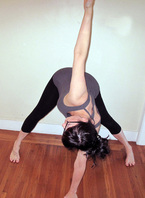 Airplane Begin standing with feet wide apart. Inhale and raise arms out to sides of body. Exhale and bring left hand down to floor, block or chair as you twist the torso to the right, grounding the left sit bone back. Inhale return to standing with arms out to the sides of body. Exhale and bring right hand down to floor, block or chair as you twist the torso to the left, grounding the right sit bone back. Repeat 5 times. 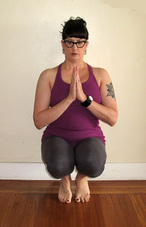 Squat Bring feet hips width apart and bend knees dropping hips down towards heels. If heels are not able to come to the floor, you can use a folded blanket under the heels. You may also sit on a block for added stability. Place palms together at the heart in Anjali Mudra. Lift the chest and relax the tailbone, feel the opening of the entire pelvic floor. Hold for 5-10 breaths. Ardha Navasana (Half Boat) Sit on the floor with a block behind you on the mat. Lean back on the edge of the block and bring the feet onto the floor in front of your pelvis. Hold behind the knees and lift the feet off the floor by engaging the belly strongly. Stay here or extend one leg straight, then the other leg, then both legs. Keep lifting chest and drawing the belly up and in. Hold for 3-5 breaths. 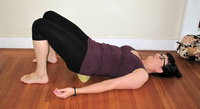 Setu Bandha (Bridge Pose) Lie on back with knees bent and feet hips width apart. Inhale and lift hips away from floor, rolling onto upper back. Place block under pelvis and rest sacrum on block. Turn toes slightly in and rest arms on floor with palms up. Hold 5-15 breaths and release.  Legs up the Wall Sit beside wall. Swing legs up wall as you lay back on mat. Rest hands on lap, belly or place arms out to sides with palms facing up. Rest at least 10-15 minutes, then roll over to release. The back should be relatively flat on the floor and the legs can be slightly bent, especially if the hamstrings are tight.
0 Comments
Leave a Reply. |
Index:Archives:
September 2022
I attend Cheryl's class regularly and feel that my practice has improved immensely over the past few years due to her expert coaching. Her teaching style is clear and compassionate and her previous experience in teaching adults is evident in her organized approach and easy to understand instructions. I also appreciate that Cheryl not only teaches us about how to correctly position ourselves, but also touches on many aspects of yoga philosophy, which in turn has deepened my personal practice and heightened my awareness of the connection between mind and body, breath and relaxation. |

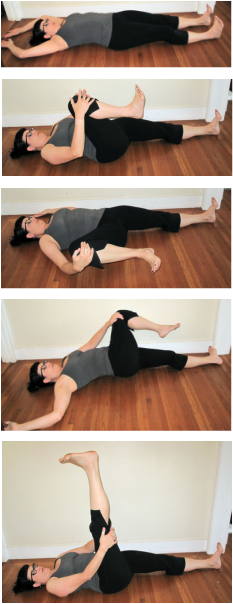
 RSS Feed
RSS Feed
